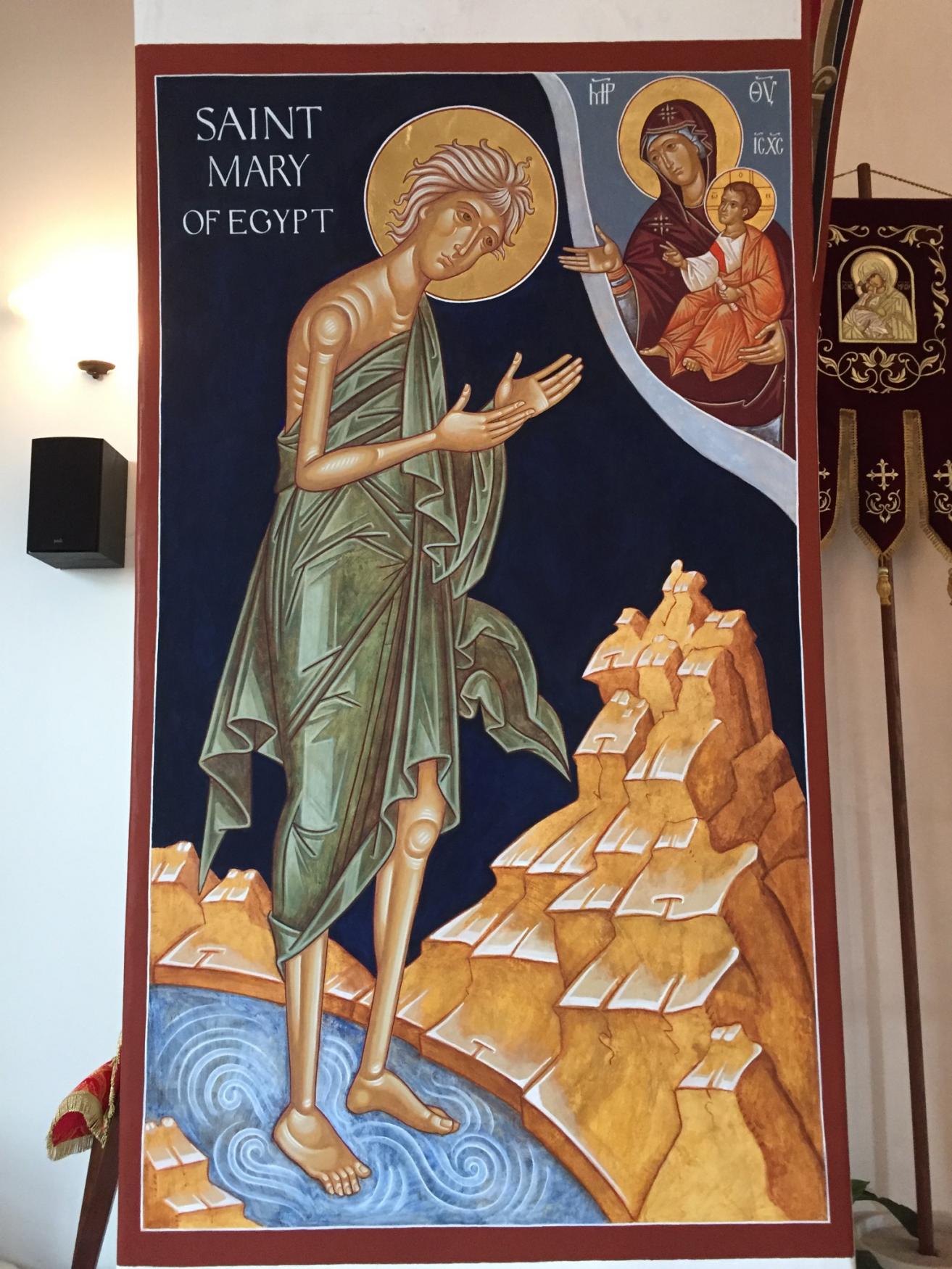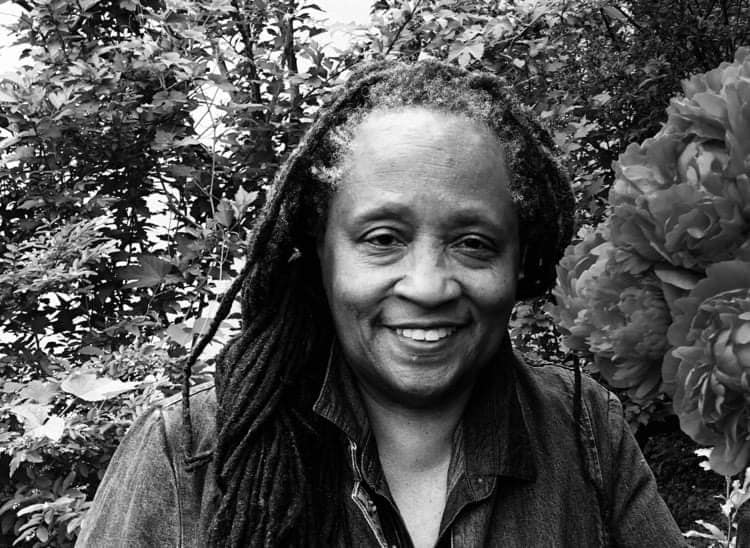
How do we know a Saint? St. Mary of Egypt is given a prominent position in the Lenten season, before Palm Sunday in the church calendar and enfolded in the majestic Canon of St Andrew of Crete.
This reflection is a review and meditation on the book “The Great Canon of St Andrew of Crete and the Life of St Mary of Egypt” by two Orthodox nuns from England, Abbess Thekla and Mother Katherine. They offer context and commentary on this service that is observed this week in Lent. They pay particular attention to St. Mary of Egypt: both the record of her life as told by the monk Sophronius,and the person herself.
Our faith, they tell us, lives in a dynamic space between two realms: one is the eternal, divine space, outside of time, beyond earthly boundaries - heavenly, holy, beyond what we can fully comprehend with our human senses -holy, holy, holy.
Our icons present this world to us. Their carefully crafted lines and pigments and symbols show us the stylized portraits of the saints.This icon is a special one in my icon corner. The iconographer is Fr.Jerome Sanderson, one of the founding members of the Fellowship of St. Moses the Black. I met him when I attended my first conference of the Fellowship while I was still in seminary and searching for a spiritual home. This icon of St. Mary of Egypt memorializes a defining moment for me. That it is a symbol from a dynamic group of devoted African American Orthodox clergy and laypeople brings an added dimension of faith, joy, and community.
The saints live in a world beyond ours. Their eyes meet ours and we are invited to look into their souls as they look into ours. It is an encounter that moves us out of the ordinary into a space where we can ask them to intercede with God and the great cloud of witnesses, and they can touch our souls. So look at Mary, her eyes are wide and her body is still. We know that Mary of Egypt looked at the icon of the Virgin Mother, the one traditionally said to be created by Luke. St. Mary of Egypt heard the voice of Mary the Theotokos, felt her presence, shared the sensations of a physical body that can hold a human and a divine life… a body just like hers. This gaze of the icon, the voice she heard, the encounter with the holy changed her life.
Icons function like that. When we look at the icon of Mary of Egypt we can get a glimpse of the holy, the eternal, and also see into the very human life of this particular person. In icons, we sense the human person. We sense people who lived on the earth, who lived and breathed. On earth they did good deeds and bad deeds. They were joyful and loving sometimes, and irritating and arrogant and shameful at others. They lived in the world as we do but through some special grace they attained sainthood. They offer us examples of how God’s grace can touch us, how we can become members of the kingdom. And then our earthly, human, messy lives, with all of our faults, become irrelevant to our new status.
We believe and live within these two parameters. Saintly, holy, aspiring to the light and God’s love and - living the day-to-day reality of working and trying to be good - failing,even though we know what’s best, and somehow still missing the mark. As John Climacus told us last week we fall and mourn our sins every day and we wake up the next day and try again.
And this helped me understand Mary in a new way, and why she’s so important to us at this time of year. This icon can lead us to her see her holiness wrapped in her skeletal form draped in rags… we see the sins and her repentance, the sacred worked out beyond the wickedness.
Like the icons, our hymns, poems, and liturgies use formal structures that convey holiness and the experience of our earthly existence. This “Life of St. Mary of Egypt” by Sophronius offers us the same opportunity. The story has two formal and familiar structures that we know from childhood: both the traditional hagiography of the sinner who sees the light and repents; and the traditional conventions of the fairy tale where the mundane and the magical exist in the same realm. This particular story brings us lively detail and vivid emotions, moments of passion and addiction. It tells us the real and also points us to the holy, the transcendent, the realm beyond an African desert where time is measured in minutes and hours and days! The language is the simple, straightforward language of the folk tale that resonates with deep meaning. We see Mary and her faith living and moving and learning within these two dimensions.
The crowds around her at the church were real. The passengers on the boat and the man who sold her the bread were real. The sexual partners, the raucous behavior, real. But so, too, were the desert heat, the hunger and isolation.
We also see the transcendent. She levitates when she prays, she walks on water, she hears the Virgin’s voice and follows the Virgin’s exhortations to be sinless by performing extreme bodily disciplines. She knows and recites passages of Scripture that she has learned without books and teachers. She can read the heart of Zosimos and tell him how to make the monastery a better community.
And, most of all, in the tradition of wonderful storytelling, these gifts are seen through the eyes of Abba Zosimos who is astounded and falls at her feet. Mary herself is humble, she hardly notices the immensity of her miraculous achievements and defers to Zosimos the monk… officially ordained, carrying the holy elements.And still she prays for God’s mercy. Zosimos has come with the pride and arrogance of his position and formal authority , yet he is stunned by her talents and gifts and mastery of Scripture. She is the embodiment of the true followers of Christ.
We don’t know when and where true grace comes to us. Mary and Zosimos both prayed, devoted their lives to God. Both had hopes of salvation but it is guaranteed to neither. Is one more worthy because he spent his life in holy orders? He needed the love he found in Mary’s life and example to gain compassion and insight. Is Mary more worthy although she spent years in harlotry and sin?
That’s why this story is fascinating at this time of year. All through Lent we are surprised, our expectations disrupted by who enters the kingdom. This is the mystery. Jesus says the proud, respected Pharisee who follows all the rules is not as blessed as the tax collector who prays for mercy. The sinful woman in today’s Gospel reading crashes a formal dinner of respectable people and actually touches Jesus, washes his feet with her tears and her hair! Her hair, from the body of a harlot, and Jesus blesses her over the Temple officials. This is mind blowing. It’s off the charts. Faith sets the blind man and the deaf man and the bent-over woman free, but the father who cries out “I do believe; forgive my unbelief” has his son cured also.
The parables leave us puzzled. Does the shepherd really leave ninety-nine sheep unattended to go after one? Is the prodigal son really forgiven when the older son has been true to his father? Is the woman caught in adultery set free because others have sinned too?
At the heart of our faith there is mystery. We follow Mary and Zosimos in prayer and fasting, we know we are fallible human creatures with glimpses of a holy world where God waits for us. We also know that we fail and have doubts and miss the mark. And we know too that the final grace is a mystery. We pray the Jesus Prayer, the nuns say , and after all our prayers and discipline, we do not arrive at an understandable truth. We arrive at a place where we know what we really don’t know.
That’s the mystery of Orthodoxy. That’s the living tradition of the stylized, timeless, beyond-space encounter that we can access through the icon; of the eight tones of the hymns; and the beauty and poetry of the liturgy. At the same time we are aware of the particular human acts and attitudes of the real people we are and the people whom we praise and chant hymns to. It is why we approach the saints for intercession and offer praise. They obtained the transcendental through the everyday.
So it is the harlotry- and sex-addicted body of Mary of Egypt - the same Mary who changes her ways, experiences her moment of metanoia when she sees the Theotokos icon and goes on to live a life of repentance, miracles and vision - that we see on the icon. We see both in one image. She saw the body of the Theotokos, she who contained the holy, through whose body came Jesus: fully human and fully divine. A woman’s body just like hers. We see a a faith that moves between our full,incarnated, physical self and our awareness of the holy.
That’s the story that is so satisfying and poignant for us today. Here’s the ending: Mary has died, she has predicted her death and left a last note to her friend.Zosimos weeps over her uncorrupted body, he weeps, and then a lion - as real as the wild animal who mangles his prey - comes to bury her, with gentleness and love. The lion, the wild animal; the lion, symbol of Christ. The lion and the monk working together.
And then they go their separate ways. Mary is buried in the desert. The monk returns to the monastery. The lion returns to the hunt. And the story is told to this day… the real and the transcendent, the dailiness and messiness of our lives, the hope for salvation, the companions we meet and through whom we encounter Christ.
Judith Scott is Axia's spiritual advisor.



